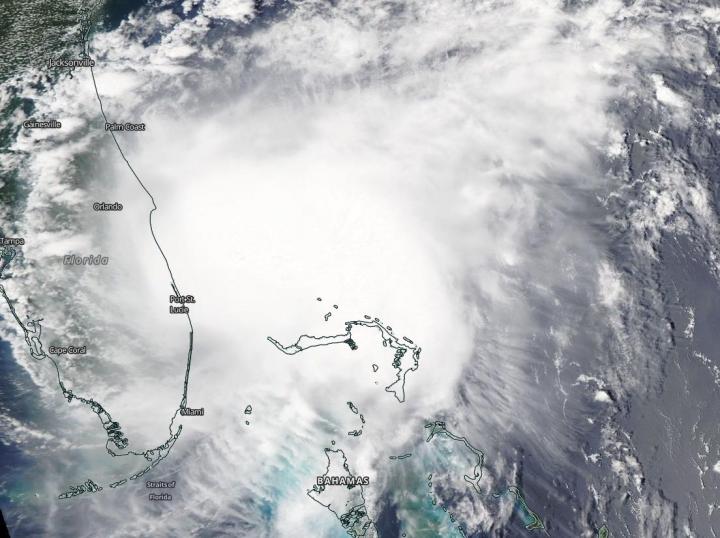
Credit: Image Courtesy: NASA Worldview, Earth Observing System Data and Information System (EOSDIS).
NASA’s Aqua satellite obtained visible and water vapor imagery as Tropical Storm Isaias continued moving along the east coast of Florida. On Aug. 3, Warnings and Watches stretched from Florida to Maine.
NASA Satellite View: Isaiah’s Organization
The Moderate Resolution Imaging Spectroradiometer or MODIS instrument that flies aboard NASA’s Aqua satellite captured a visible image of Tropical Storm Isaias on Aug. 2 at 1:30 p.m. EDT. There was no visible eye in the storm at the time of the imagery. The satellite image was created using NASA’s Worldview product at NASA’s Goddard Space Flight Center in Greenbelt, Md.
Water Vapor Imagery Shows Location of Heaviest Rain
NASA’s Aqua satellite passed over Isaias on Aug. 3 at 3:45 a.m. EDT (0745 UTC) when it was off the coast of northeastern Florida and found highest concentrations of water vapor and coldest cloud top temperatures were offshore and mostly north and northeast of the center.
NHC noted, “Isaias continues to produce an area of vigorous convection near and to the northeast of its low-level center. Overnight radar data from Melbourne and Jacksonville have shown a transient mid-level eye feature that is located northeast of the low-level center.”
Coldest cloud top temperatures were as cold as or colder than minus 70 degrees Fahrenheit (minus 56.6 degrees Celsius) in those storms. Storms with cloud top temperatures that cold have the capability to produce heavy rainfall.
Water vapor analysis of tropical cyclones tells forecasters how much potential a storm has to develop. Water vapor releases latent heat as it condenses into liquid. That liquid becomes clouds and thunderstorms that make up a tropical cyclone. Temperature is important when trying to understand how strong storms can be. The higher the cloud tops, the colder and stronger they are.
The heavy rain potential in the storm is in the forecast as Isaias makes landfall and moves northeast along the U.S. East Coast. The National Hurricane Center (NHC) noted, “Heavy rainfall will result in flash and urban flooding, some of which may be significant in the eastern Carolinas and the mid-Atlantic, through midweek along and near the path of Isaias across the East Coast of the United States. Widespread minor to moderate river flooding is possible across portions of the Carolinas and the mid-Atlantic. Additionally, quick-responding rivers in the southern Appalachians and Northeast will be susceptible to minor river flooding.”
Warnings and Watches Posted All Along U.S. East Coast
On Aug. 3, 2020, the National Hurricane Center posted watches and warnings along the U.S. East coast from Florida to Maine.
A Storm Surge Warning is in effect for Edisto Beach, South Carolina to Cape Fear, North Carolina. A Storm Surge Watch is in effect for Cape Fear to Duck, North Carolina and the Pamlico and Albemarle Sounds. A Hurricane Warning is in effect for South Santee River, South Carolina to Surf City, North Carolina. A Tropical Storm Warning is in effect for Flagler/Volusia County Line, Florida to South Santee River, South Carolina; north of Surf City, North Carolina to west of Watch Hill, Rhode Island; Chesapeake Bay south of North Beach; Tidal Potomac River south of Cobb Island; Delaware Bay; Long Island and Long Island Sound; Pamlico and Albemarle Sounds. A Tropical Storm Watch is in effect for Watch Hill, Rhode Island to Stonington, Maine and for Martha’s Vineyard, Nantucket, and Block Island.
Tropical Storm Isaias on Aug. 3
At 8 a.m. EDT (1200 UTC) on Aug. 3, the center of Tropical Storm Isaias was located by an Air Force Reserve reconnaissance aircraft and NOAA Doppler weather radars near latitude 30.2 degrees north and longitude 80.1 degrees west. That is about 100 miles (155 km) east-southeast of Jacksonville, Fla. and about 250 miles (400 km) south-southwest of Myrtle Beach, So. Carolina. The estimated minimum central pressure is 994 millibars.
Isaias is moving toward the north near 13 mph (20 kph). A turn toward the north and north-northeast along with an increase in forward speed is expected later today and Tuesday, Aug. 4. Maximum sustained winds are near 70 mph (110 kph) with higher gusts. Some strengthening is anticipated today, and Isaias is forecast to regain hurricane strength before it reaches the coast of northeastern South Carolina or southern North Carolina tonight. Slow weakening is forecast after Isaias makes landfall in the Carolinas and moves across the U.S. mid-Atlantic region tonight and Tuesday.
An 8 a.m. EDT Florida Observation on Aug. 3
During the 7 a.m. hour a wind gust to 40 mph (65 kph) was observed at the St, Augustine Pier, Florida, and a sustained wind of 34 mph (55 kph) and a gust to 40 mph (65 kph) were measured by a Weatherflow station at the Jacksonville Beach Pier, Florida.
Isaias’ Forecast and Track
The NHC Discussion at 8 a.m. EDT on Aug. 3 noted that the vertical wind shear that has been plaguing Isaias is forecast to abate slightly today as the storm turns north-northeastward. All of the intensity models shows some slight strengthening during the next 12 hours, and the global models also indicate some deepening. As a result, the updated NHC intensity forecast calls for Isaias to regain hurricane status before the system moves over the coast of the Carolinas.
The NHC noted, “On the forecast track, the center of Isaias will pass well east of the Georgia coast through this morning. The center of Isaias will then approach the coast of northeastern South Carolina and southern North Carolina within the hurricane warning area later today. The center will then move inland over eastern North Carolina tonight, and move along the coast of the mid-Atlantic states on Tuesday and into the northeastern United States by Tuesday night.”
###
About NASA’s Worldview and Aqua Satellite
NASA’s Earth Observing System Data and Information System (EOSDIS) Worldview application provides the capability to interactively browse over 700 global, full-resolution satellite imagery layers and then download the underlying data. Many of the available imagery layers are updated within three hours of observation, essentially showing the entire Earth as it looks “right now.”
NASA’s Aqua satellite is one in a fleet of NASA satellites that provide data for hurricane research.
Tropical cyclones/hurricanes are the most powerful weather events on Earth. NASA’s expertise in space and scientific exploration contributes to essential services provided to the American people by other federal agencies, such as hurricane weather forecasting.
For updated forecasts, visit: http://www.
By Rob Gutro
NASA’s Goddard Space Flight Center
Media Contact
Rob Gutro
[email protected]
Original Source
https:/




